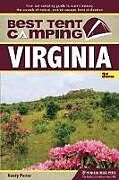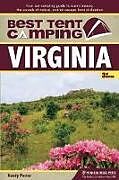Best Tent Camping: Virginia
Einband:
Kartonierter Einband
EAN:
9780897325066
Untertitel:
Your Car-Camping Guide to Scenic Beauty, the Sounds of Nature, and an Escape from Civilization
Genre:
Reiseführer allgemein
Autor:
Randy Porter
Herausgeber:
MENASHA RIDGE PR
Auflage:
3., überarbeitete Auflage
Anzahl Seiten:
192
Erscheinungsdatum:
15.04.2014
ISBN:
978-0-89732-506-6
Autorentext
Randy Porter has been tromping around Virginia's nooks and crannies for more than 40 years and is an avid cyclist, hiker, camper, and sea kayaker. The author of Mountain Bike! Virginia, he lives in Charlottesville, VA.
Klappentext
From the storied coastline along the Atlantic Ocean and Chesapeake Bay to the majestic mountains of the Appalachians in the west and the Shenandoah Valley below, the Old Dominion provides a spectacular backdrop for some of the most scenic campgrounds in the country. Hundreds of miles of trails and rivers lace the countryside around these forest hideaways, opening the door to endless adventure.
In Best Tent Camping: Virginia, outdoors writer and enthusiast Randy Porter has complied the most up-to-date research to steer you straight to the safe and scenic treasure spot you had in mind.
Zusammenfassung
Offering essential details and easy-to-read maps, Best Tent Camping: Virginia presents 50 of the state's best campgrounds for car campers.
Leseprobe
BIG MEADOWS CAMPGROUND
You're likely to see white-tailed deer, song sparrows, meadowlarks, grouse, foxes, and skunks.
Beauty 4 stars
Site Privacy 4 stars
Spaciousness 4 stars
Quiet 4 stars
Security 4 stars
Cleanliness 5 stars
KEY INFORMATION
ADDRESS: Skyline Drive, milepost 51
OPERATED BY: National Park Service
CONTACT: 540-999-3500, ext. 3231; nps.gov
OPEN: Weather dependent; spring-late autumn
SITES: 217
SITE AMENITIES: Picnic table, fire grill
ASSIGNMENT: On arrival by camper; assigned on busy weekends
REGISTRATION: By reservation at recreation.gov or on arrival
FACILITIES: Camp store, laundry, coin-operated showers, lodge with restaurant
PARKING: At campsites and at laundry and shower area
FEE: $20 per night, plus $15 park entrance; discounts for holders of Interagency Senior/Access passes and Golden Age/Access passes
ELEVATION: 3,600 feet
RESTRICTIONS:
PETS: On 6-foot leash or shorter; clean up after pet
FIRES: Only in camp stoves and fireplaces
ALCOHOL: Permitted
VEHICLES: No limit
OTHER: Do not damage any trees; wash dishes at campsite only; discard gray water in service sinks at restrooms; maximum 6 people, 2 tents, 2 vehicles per site; quiet hours 10 p.m.-6 a.m.; noise limit for generators and use restricted to 8-10 a.m. and 4-7 p.m. Big Meadows is Shenandoah National Park's largest treeless area, encompassing a barren plateau that is approximately 640 acres. It's believed that American Indians cleared the area to create favorable grazing conditions. European settlers overgrazed this site with beef cattle, especially during the Civil War. Park officials have waged an ongoing battle against the growth of black locust and blackberry that would, if left unchecked, take over the meadow. In the past, Park Service officials used combinations of burning and mowing to hold back the growth of invasive vegetation. New strategies have aided in the establishment of meadow grasses. Today, the dominant shrub growth in the meadow is blueberry, with swamp varieties, such as marsh marigold, swamp fern, and Canadian burnet, growing in wetter areas. Overall, the meadow supports some 270 species of vascular plants. In addition to the white-tailed deer that wander seemingly carefree through the meadow, you're also likely to see song sparrows, meadowlarks, grouse, foxes, and skunks.
The park's dedication was held at Big Meadows, the spiritual center of Skyline Drive, on July 3, 1936. President Franklin D. Roosevelt himself was on hand to formally open the facilities at Shenandoah National Park. The meadow is located across Skyline Drive from the Harry F. Byrd Visitor Center, which houses informative exhibits, a library, an auditorium, interpretive programs, and an array of literature about Shenandoah National Park that is on sale in the small gift shop. Be sure to pick up a copy of Explore Shenandoah, the park's newsletter, for a great overview of where things are located in Shenandoah National Park as well as times and locations for ranger programs.
Big Meadows, with its visitor center, lodge, restaurant, and campground, is located in the central section of the park at mile 51.2. After pulling off Skyline Drive near the Byrd Visitor Center, follow the signs to the registration station for Big Meadows Campground. Its 217 sites are situated on two large loops, the front one containing loops PT, and the rear section containing UY. Except for sites 153, which are tents only, all are designated RV sites, despite the lack of hookups.
The sites are spacious and separated by considerable foliage. Park officials did a good job of placing a large number of sites close to each other without sacrificing seclusion. This is, of course, relative; those of you who relish your solitude will accept the slight inconvenience of walking 10100 yards and opt for one of the walk-to sites.
The walk-to sites are set off in the wooded edge of Big Meadows Campground and are very private. Sites 18 are set between the main entrance road and the camp road and tend to be noisier than the others, but appealing sites 2934 and 4453 are set off by themselves in the woods. Sites 1221 and 2434 are in grassy and less wooded areas but are still highly desirable if you don't mind carrying your gear a short distance to your site. There are no sites 25 and 26. Big Meadows Campground is a popular stopover for campers in Shenandoah National Park, especially in the fall, and it is the only one that accepts reservations. If you can plan your stay during the week, you'll find considerably fewer neighbors, but calling ahead is a good idea at any time.
As in the rest of this nearly 300-square- mile park through which 101 miles of the famed Appalachian Trail passes, there is no shortage of hiking trails. However, the Big Meadows area is especially blessed with trails for hikers of varied ages and ability levels. The 1.8-mile Story of the Forest Nature Trail is a relatively easy walk starting from the Byrd Visitor Center. Interpretive signs explain various aspects of the surrounding forest. The 3.3-mile Lewis Falls Trail pro- vides more of a challenge in terms of length and change in elevation after it exits the amphitheater parking lot. The hike to the 81-foot falls is worth the effort.
Camp Hoover (aka Rapidan Camp), located across from Big Meadows 6.3 miles down the Rapidan Fire Road, was a favorite getaway for President Herbert Hoover. The walk to Camp Hoover can be shortened to a 4-mile out-and-back by taking the Mill Prong Trail. Camp Hoover is a beautiful spot where 3 of the original 13 cabins remain at the confluence of Mill Prong, Laurel Prong, and the Rapidan River. In the summer, three-hour van tours are available several days a week. Sign up in advance at the Byrd Visitor Center. While many campers make their pilgrimage to Shenandoah National Park in the fall when colors are at their most varied and brightest, May represents the peak time for wildflowers in the meadow. Getting There
From the Swift Run Gap Entrance Station at mile 65.7, drive north on Skyline Drive to Big Meadows at mile 51.2 .
GPS COORDINATES N38° 31.709 W78° 26.334
Inhalt
Virginia Overview Map
Overview Map Key
Best Campgrounds
Acknowledgments
Preface
Introduction
COASTAL VIRGINIA
Belle Isle State Park
Chippokes Plantation State Park
First Landing State Park
Kiptopeke State Park
Newport News Park
Northwest River Park
Westmoreland State Park
THE PIEDMONT
Bear Creek Lake State Park
Fairy Stone State Park
Holliday Lake State Park
James Rive…

Leider konnten wir für diesen Artikel keine Preise ermitteln ...
billigbuch.ch sucht jetzt für Sie die besten Angebote ...
Die aktuellen Verkaufspreise von 6 Onlineshops werden in Realtime abgefragt.
Sie können das gewünschte Produkt anschliessend direkt beim Anbieter Ihrer Wahl bestellen.
Loading...
Die aktuellen Verkaufspreise von 6 Onlineshops werden in Realtime abgefragt.
Sie können das gewünschte Produkt anschliessend direkt beim Anbieter Ihrer Wahl bestellen.
| # | Onlineshop | Preis CHF | Versand CHF | Total CHF | ||
|---|---|---|---|---|---|---|
| 1 | Seller | 0.00 | 0.00 | 0.00 |
